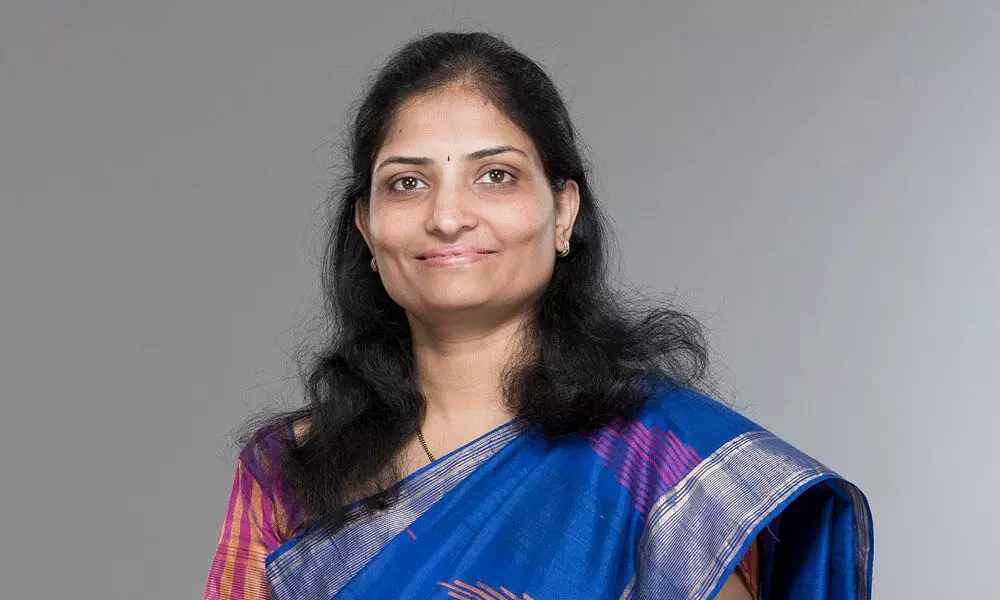Live
- ‘Get Set, Grow Summit 2024’ Focuses on Digital Detox for Families
- Stokes motivates his team to put in extra effort, says England pacer Potts
- From overcoming setbacks to leading India in U19 Women’s Asia Cup, Niki Prasad's amazing journey
- Driving Enterprise Security: Inside Venkata Reddy Thummala’s Leadership Journey
- Constitution debate: PM Modi hails 'Nari Shakti'; makes strong pitch for 'United Bharat’
- Abhijeet Bhardwaj: Revolutionizing Enterprise Analytics with Innovation and Expertise
- Bihar: Inquiry initiated against principal who went to buy veggies during school hours
- Press Sri Lankan Prez for release of Indian fishermen: TN Cong MP to EAM Jaishankar
- TN: DMK postpones executive meet due to heavy rains & Parliament session
- Porous silicon oxide electrodes can fix durability issues in batteries: Researchers
Just In
Bengaluru: Aster doctors save woman with uterine fibroid


Dr. Bharati Kamoji, senior OBG Consultant, Aster CMI Hospital
In yet another show of excellence and prowess, doctors at Aster CMI Hospital gave a new lease of life to a 28-year-old woman by removing a fibroid (non-cancerous tumour) from her body while preserving her uterus.
Bengaluru: In yet another show of excellence and prowess, doctors at Aster CMI Hospital gave a new lease of life to a 28-year-old woman by removing a fibroid (non-cancerous tumour) from her body while preserving her uterus.
The 11x10 cm fibroid in the uterus, was infected and the infection had spread to the uterine, fallopian tubes and ovaries. The patient was admitted to the hospital with an acute onset of severe lower abdominal pain and had a history of fever and blood-stained foul smelling vaginal discharge on and off for 2 weeks. In a surgery that lasted for three hours, Dr. Bharati Kamoji, senior OBG Consultant, Aster CMI Hospital, removed the fibroid from the woman's uterus and ensured her full recovery.
Anitha (name changed) suffered from the condition for a couple of years even though her menstrual periods had always been regular. Before she consulted the doctors, she had one preterm delivery at 29 weeks and the baby had passed on the 4th day of his birth. In the ensuing years, she also had an Preterm Premature Rupture of the Membranes (PPROM) that had resulted in a miscarriage, when she was 20 weeks 4 days pregnant.
After two months, she was presented with the above symptoms to the ER. On examination, her vital parameters revealed signs of sepsis (high temperature, high pulse rate, low blood pressure and high respiratory rate). On abdominal examination, it was revealed that she had a presence of a firm, irregular, tender and mobile mass arising from the pelvis, corresponding in size to a pregnant uterus of 16 weeks' gestation along with severe tenderness all over the abdomen.
On further per speculum examination, it was found that the woman had a fungating and degenerated mass of 7x5 cms filling in her vagina with a frank pus discharge. MRI of abdomen and pelvis with contrast showed bulky uterus with a large heterogeneous lesion (4.6 x 3.7 x 11.2 cm) with degeneration (hemorrhagic/cystic), extension into the endocervical canal (5.7 x 3.3 cm) and distorting the endometrial cavity (possibly pedunculated), bilateral pyosalpinx and infected loculative pelvic collection along the fundus (5.3 x 9.0 x 5.5 cm).
Explaining the complications in the surgery, Dr. Bharati Kamoji, Senior OBG Consultant, Aster CMI Hospital, said: "Uterine fibroid is usually a non-cancerous tumour of the uterus affecting women of reproductive age. They are also called leiomyomas or myomas which may be present without any symptoms, but sometimes can be the cause of heavy bleeding during periods, anemia, abdominal pain, or infertility. What made the procedure more challenging was not just the presence of the infected fibroid, but also the infection spread to the uterus, fallopian tubes and ovaries. The patient was keen to conserve her uterus and hence we opted for removal of fibroid to preserve her fertility."
The procedure was three hours long and the doctors had to plan her surgery in a systematic manner by providing a detailed counselling to the family about her condition and explained to them the possibility that she may require hysterectomy in view of extensive spread of infection.
"We started with laparoscopy, then proceeded to perform laparotomy and drained about 300 – 400 ml of pus from the infected area and the fallopian tubes were removed because of infection but ovaries were conserved. In addition, the remaining fibroids stuck to the uterine cavity were also removed. Post the surgery, the patient was treated with broad-spectrum antibiotics to improve her hemoglobin levels. We offered her counselling regarding recurrence and future fertility. The patient is currently in good condition and is undergoing post-operative follow-up," added Dr. Bharati Kamoji.

© 2024 Hyderabad Media House Limited/The Hans India. All rights reserved. Powered by hocalwire.com






